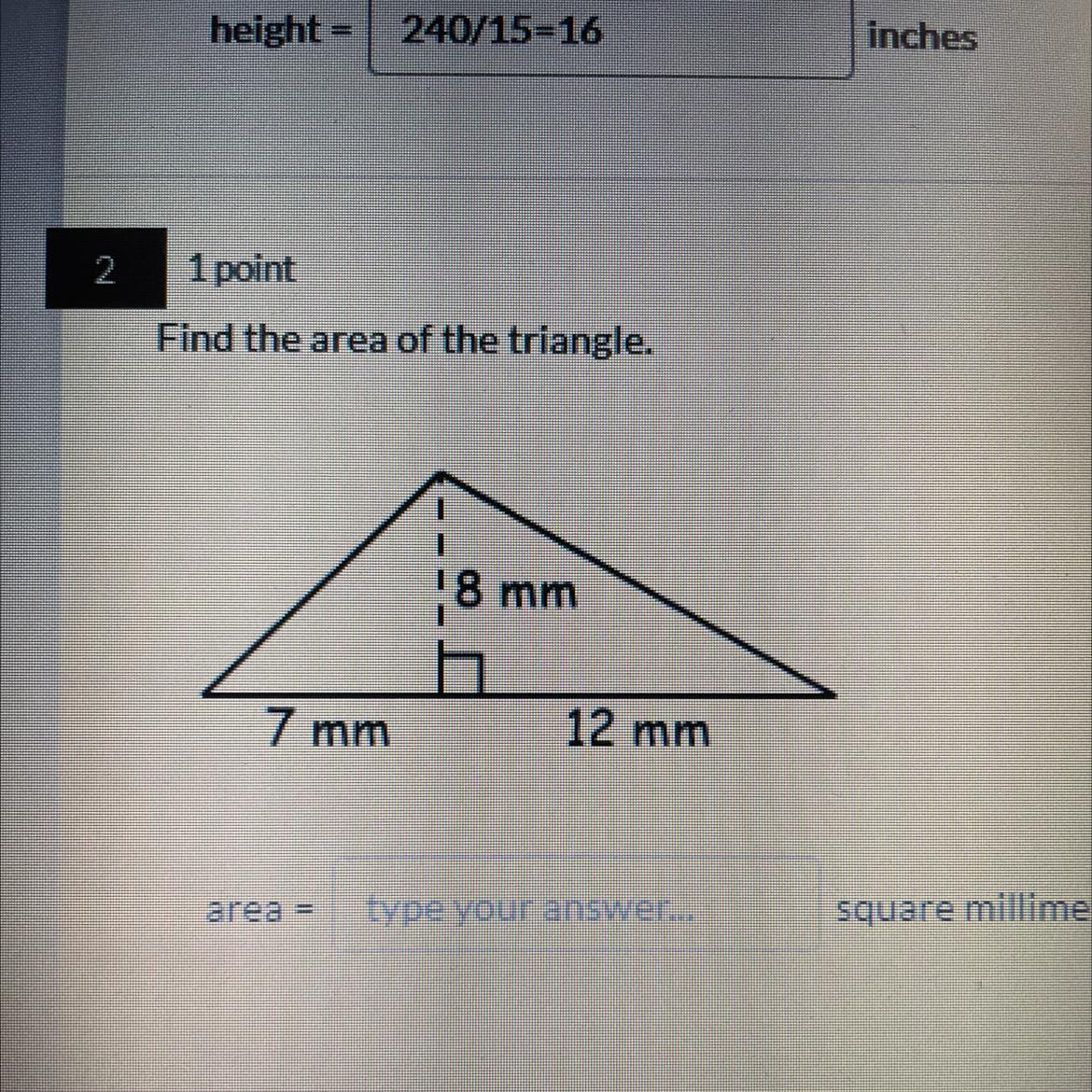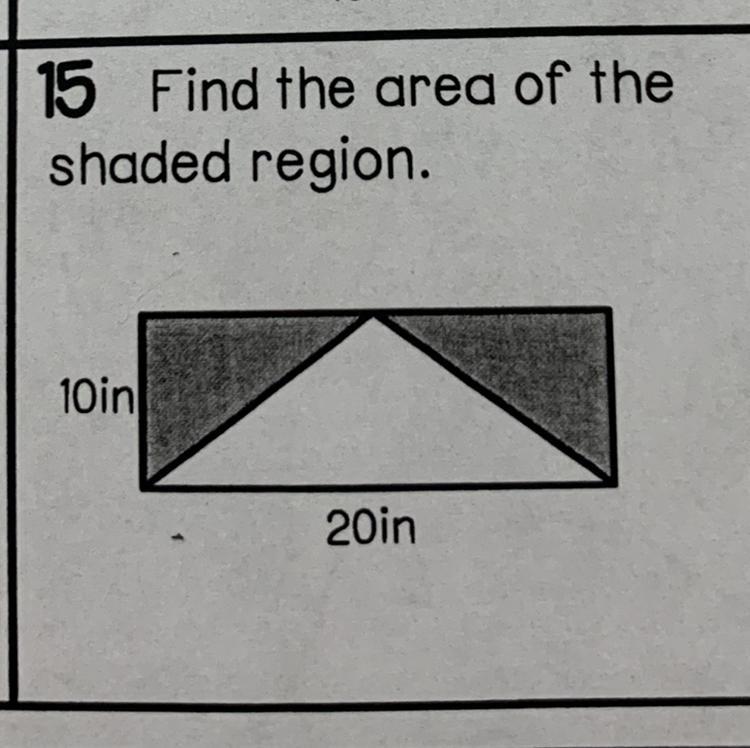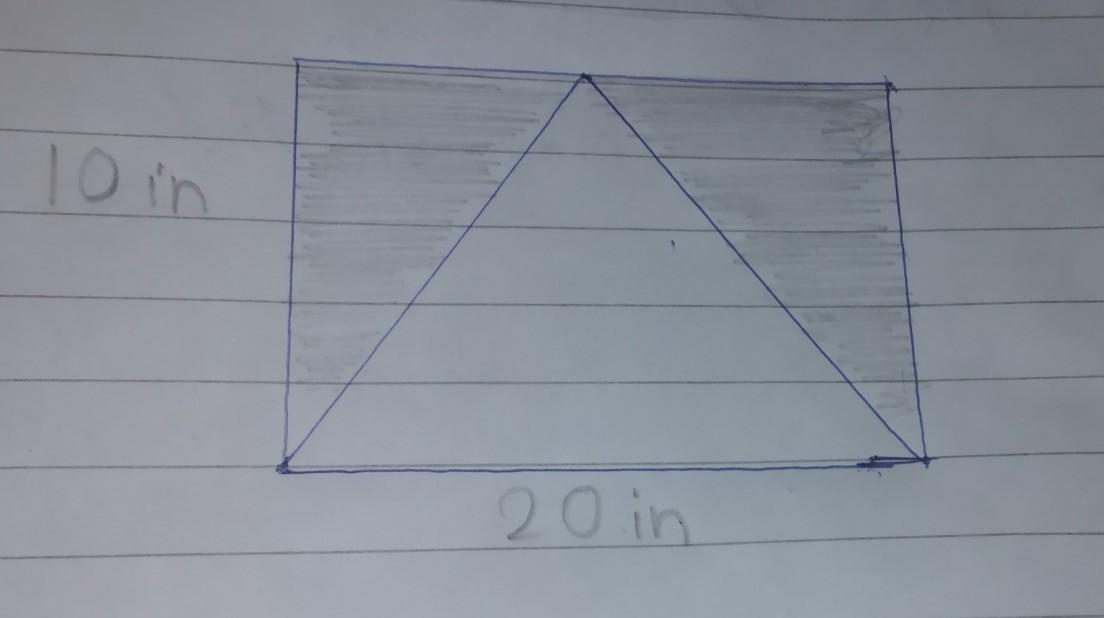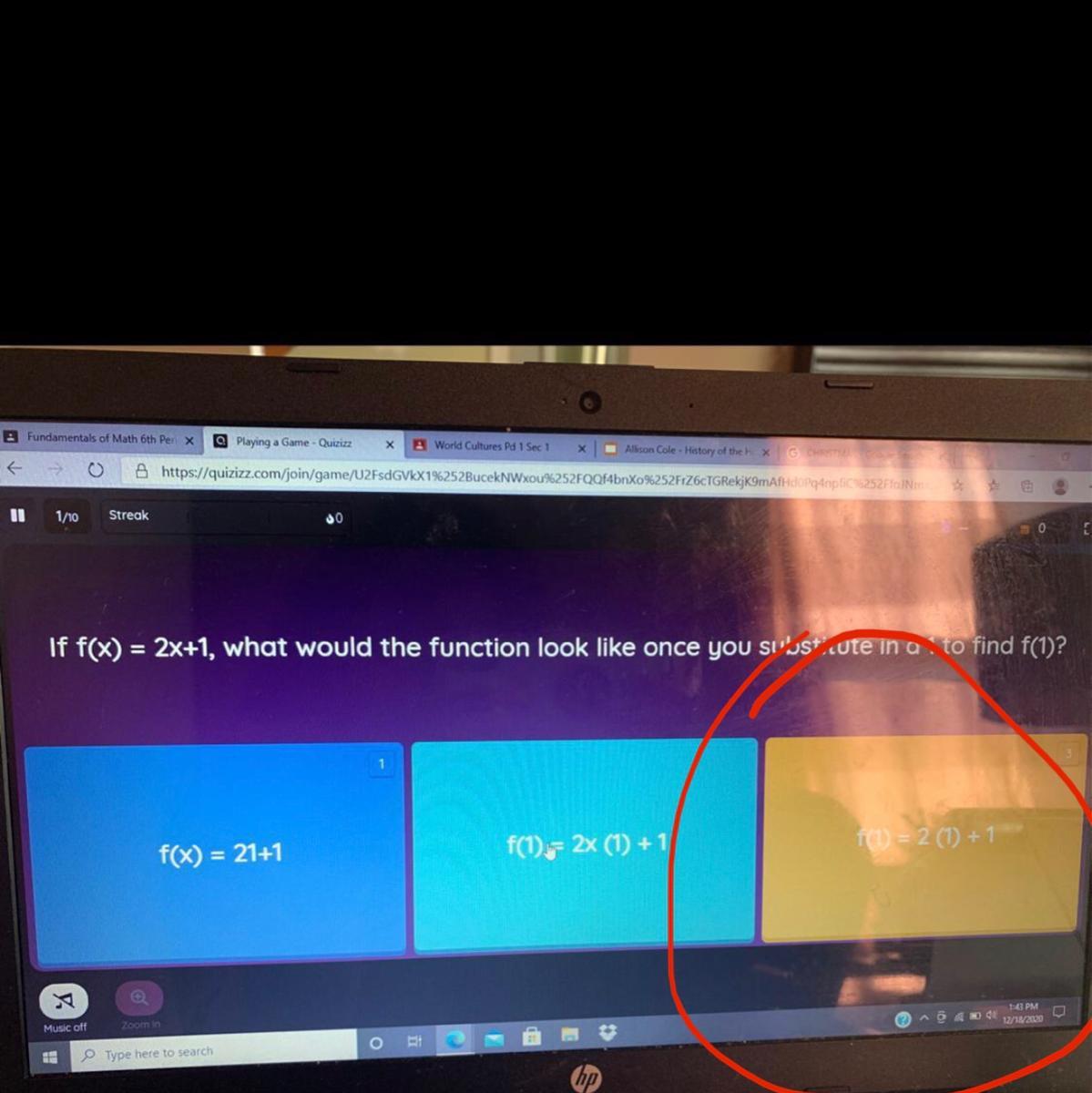Which estimate is closest to the actual value?
3.749237 x 1.84623
-8.2
-6.9
-3.6
-5.5
Answers
Answer:
Answer is -6.9
Step-by-step explanation:
I hope it's helpful!
Related Questions
find the difference of (-10x^2 + 5x -3) and (4x^2 + 6x - 7)
Answers
Answer:
-14x² - x + 4
Step-by-step explanation:
(-10x² + 5x - 3) - (4x² + 6x - 7)
= (-10x² + 5x - 3) - (+4x²) - (+6x) - (-7)
= (-10x² + 5x - 3) -4x² -6x +7
= -10x²-4x² +5x-6x -3+7
= -14x² - x + 4
¿Cuál es el valor de la "x" en la ecuación 1/2x+3=6?
Answers
Answer:
x=1.5
Step-by-step explanation:
No hablo espanol
Find the area of the triangle

Answers
Answer:
Hello! answer: 76
Step-by-step explanation:
Formula to find area is base × height ÷ by 2 12 + 7 = 19 19 × 2 = 152 152 ÷ 2 = 76 HOPE THAT HELPS!
retangular form of r=8 sin theta
Answers
Answer:
Step-by-step explanation:
r2=x2+y2,tanθ=yx,x=rcosθ,y=rsinθ
Divide (5x^4-33x^3+13x^2+25x+20) by (x-6) using long polynomial divison.
Answers
I just need help with the range domain is [-2,3)

Answers
Answer:
We don't need to worry about the displaystyle- {3} −3 anyway, because we dcided in the first step that displaystyle {x}ge- {2} x ≥ −2. So the domain for this case is displaystyle {x}ge- {2}, {x}ne {3} x≥ −2,x≠ 3, which we can write as displaystyle {left [- {2}, {3}right)}cup {left ({3},inftyright)} [−2,3)∪(3,∞).
Step-by-step explanation:
10. A boxer was able to land 10 punches in 4 rounds. At this rate, how many punches
would he land in 9 rounds? If you get stuck, consider using the table.
punches
round
10
4
1
9
Answers
Answer:
22.5 punches in 9 rounds.
Step-by-step explanation:
To find the number of punches in 1 round, you divide 4 by 4 and 10 by 4. 4 divided by 4 is 1. 10 divided by 4 is 2.5. Next, multiply 1 by 9 to get 9. Then multiply 2.5 by 9 to get 22.5
So, a boxer can land 22.5 punches in 9 rounds. If you need to round, it would be 23 punches in 9 rounds.
Hope this helps!
If f(x)={−2x+1x−8ififx<3x≥3, what is f(7)
Answers
Evaluating in x = 7 in the second piece of the function, we get:
f(7) = 1.
How to evaluate the piecewise function?
Here we have the piecewise function:
f(x) = -2x + 1 if x < 3
f(x) = x - 8 if x ≥ 3
Where the part in the right defines the domain of each piece of the function.
And we want to evaluate in x = 7, then we need to use the second part (because 7 is larger than 3). Replacing x by 7 we get:
f(7) = 7 - 8 = -1
f(7) = -1
Learn more about piecewise functions:
https://brainly.com/question/3628123
#SPJ1
What is the decimal for this grid?
0.04
4.0
0.004

Answers
Find the area of the shaded region.

Answers
Answer:
The Area of the shaded region would be 100 in^2 .
Step-by-step explanation:
Given:
Check the Attachment.
To Find:
The Area of Shaded Region
Solution:
The Triangle and the Rectangle have the same base(b) that is equal to the length(l) of the rectangle.
Note that Height of the triangle is same as breadth of the rectangle.
Now Let's come in the main solving part :-
We know that the formula of Area of the Triangle is ;
\(\boxed{ \rm \: Area \: of \: Triangle= \tt \: 1/2× \rm \: base×height , i.e. \: \tt \: 1/2× \rm\: b×h}\)
Substitute the values where Base= 20 in and Length = 10 in:
\( \tt \: Area \: of \: Triangle=1/2×20 \: \times 10\)
Now Solve it.
\( \tt \: Area \: of \: Triangle= \cfrac{1}{ \cancel2 {}^{1} } \times \cancel{20} {}^{10} \times 10\)
\( \tt \: Area \: of \: T riangle = 10 \times 10\)
\( \tt \: Area \: of \: Triangle=\boxed{\tt 100 \: in {}^{2}} \)
Hence, the area of the shaded region is 100 sq.in or 100 in^2 .
\( \rule{225pt}{2pt}\)
I hope this helps!
Let me know if you have any questions. :)

Two trains leave stations 396 miles apart at the same time and travel toward each other. One train travels at 80 miles per hour while the other travels
at 100 miles per hour. How long will it take for the two trains to meet?
Answers
Answer:
It will take 2.2 hours for the trains to meet.
Step-by-step explanation:
Given,
Distance between two trains = 396 miles
Speed of one train = 95 mph
Speed of other train = 85 mph
Combined speed of trains = 95+85 = 180 mph
Distance = Speed * Time
Time =
Time =
Time = 2.2 hours
It will take 2.2 hours for the trains to meet.
Keywords: speed, distance
Learn more about distance at:
brainly.com/question/13219835
brainly.com/question/1836777
#LearnwithBrainly
Step-by-step explanation:
The subjects of an experiment should be selected at random so that they
represent the population from which they come.
O
A. True
O
B. False
Answers
Answer: True
Step-by-step explanation:
The subjects of an experiment should be selected at random so that they
represent the population is true.
Once the sample size has been decided, a sample should be taken from the sample size which will represent the population. This gives everyone an equal chance of being selected as there's no bias.
so how do you know if D IS WONG!!!!
Answers
Answer:
What are you referring to?
Step-by-step explanation:
The James used their sprinkler for 40 hours last month and the Jenkins used their sprinkler for 35 hours. The total output of the two houses was 1525 L. If their combined rate of usage was 40 L/hr, what is the rate of usage for each house?
Answers
Answer:
Step-by-step explanation:
.................8908989
u(x) = -x+1
w (x) = - 2x²+2
Find the following.
(u • w)(4) =
(w. u) (4) =
Answers
Explanation: Plug in 4 for x and you can solve the equation
The illumination of an object by a light source is directly proportional to the strength of the source and inversely proportional to the square of the distance from the source. If two light sources, one three times as strong as the other, are placed 14 ft apart, how far away from the stronger light source should an object be placed on the line between the two sources so as to receive the least illumination? (Round your answer to two decimal places.)
Answers
Answer:
≥ 8.88 feet
Step-by-step explanation:
The illumination of an object by a light source is directly proportional to the strength of the source and inversely proportional to the square of the distance from the source.
I = s/d^2
The object is placed between the sources which are 14 feet apart
at a point where
Week = strong
s/x^2 = 3s/(14 - x)^2
cross multiply
(14 - x^2)s = 3sx^2
Divide both sides by s
(14 - x)^2 = 3x^2
Expand
196 - 28x + x^2 = 3x^2
subtract (196 - 28x + x^2) from both sides
2x^2 +28x - 196 = 0
Divide both sides by 2
x^2 + 14x - 98 = 0
Solve using quadratic equation
(work not shown)
x = {-19.1244, 5.12436}
disregard the negative root since the distance cannot be negative
x = 5.12436
14 - x = 8.87564
Rounded
8.88 feet
The Venn diagram shows the number of customers who have purchased different types of pets from a pet store, where C represents customers who have purchased cats, D represents customers who have purchased dogs, and F represents customers who have purchased fish.
Circles C, D, and F overlap. Circle C contains 15, circle D contains 21, and circle F contains 12. The overlap of C and F contains 2, the overlap of F and D contains 0, and the overlap of D and C contains 3. The overlap of all 3 circles contains 1. Number 14 is outside of the circles.
How many people are in the set C ∩ D?
4
6
36
38
Answers
The number of people in the set C ∩ D (customers who purchased both cats and dogs) is obtained by adding the overlap of D and C (3) with the overlap of all 3 circles (1), resulting in a total of 4 individuals.
The correct answer is 4.
To determine the number of people in the set C ∩ D (customers who have purchased both cats and dogs), we need to analyze the overlapping regions in the Venn diagram.
Given information:
- Circle C (cats): 15
- Circle D (dogs): 21
- Circle F (fish): 12
- Overlap of C and F: 2
- Overlap of F and D: 0
- Overlap of D and C: 3
- Overlap of all 3 circles: 1
- Number outside of circles: 14
To determine the number of people in the set C ∩ D (customers who have purchased both cats and dogs), we need to consider the overlapping region between circles C and D.
From the information given, we know that the overlap of D and C is 3. Additionally, we have the overlap of all 3 circles, which is 1. The overlap of all 3 circles includes the region where customers have purchased cats, dogs, and fish.
To calculate the number of people in the set C ∩ D, we add the overlap of D and C (3) to the overlap of all 3 circles (1). This gives us 3 + 1 = 4.
Therefore, from the options given correct one is 4.
For more such information on: set
https://brainly.com/question/24713052
#SPJ8
Answer: 4
Step-by-step explanation:
trust me bro
CAN SOMEONE PLEASE HELP ME??

Answers

A. B and C represent 3 points on horizontal ground. A is due South of B. The point C is 400 m due East of B and on a bearing of 028" from A. A helicopter flies due South at constant height and speed, passing over B at Y, and heading towards Y. Y, is directly over A. The helicopter flies at a height of 600 m above the ground. Calculate a). b). c). d). e). f). g). the distance CY the angle of elevation of the helicopter at Y, from C, the distance AB, the angle of elevation of the helicopter at Y, from A. the distance AC, the angle of elevation of the helicopter at Y, from C, the helicopter takes 20 s to pass from Y, to Y,. At what speed is the helicopter travelling in Km/h? A North
Answers
The elevation of the helicopter and the relative positions of the points A, B, and C indicates that we get the following approximate values;
(a) CY₂ = 200·√(13)
(b) 56.3°
(c) 752.29 m
(d) 38.57°
(e) 852 m
(f) 35.15°
(g) 37.6 m/s
What is an angle of elevation?The angle of elevation of one point from another point is the angle formed from the line of sight from the lower point to the elevated point.
The distance to C from B = 400 m
The point A is due south from B
C is on a bearing 028° from A
(a) The point the helicopter passes over B = Y₂
The point the directly over A to which the helicopter is heading = Y₁
CY₂ = √(600² + 400²) = 200·√(13)
(b) The angle of elevation of the helicopter at Y₂ from C = arctan(600/400) ≈ 56.3°
(c) The distance AB, can be found using the trigonometric ratios for the tangent of an angle as follows;
tan(28) = BC/AB
BC = 400, therefore;
AB = 400/tan(28) ≈ 752.29 meters
(d) The angle of elevation is; arctan(600/(400/tan(28)) ≈ 38.57°
(e) The Pythagorean Theorem for the lengths of the sides of the right triangle formed by the points A, B, and C, indicates that we get;
AC = √(400² + ((400/tan(28))²) ≈ 852 meters
(f) The angle of elevation of the helicopter at Y₁ from C = arctan(600/√(400² + ((400/tan(28))²)) ≈ 35.15°
(g) The distance from Y₂ to Y₁ = The distance AB = 400/tan(28)
Therefore, the speed of the helicopter = 400/tan(28)/20 ≈ 37.6 m/s
Learn more on angle of elevation here: https://brainly.com/question/12702806
#SPJ1
Simplify the following:
(-4x^3-14x^2+10x-1) ÷(2x-1)
Show your work.
Can someone please help for college prep math
Answers
Answer:
\(1-8x-2x^2\)
Step-by-step explanation:
(-4x^3-14x^2+10x-1)÷(2x-1)
Factor the expressions that are not already factored.
\(\frac{(2x-1)(2x^2-8x+1)}{2x-1}\)
Cancel out 2x−1 in both numerator and denominator.
\(2x^2-8x+1\)
Swap terms to the left side.
\(1-8x-2x^2\)
Graph if needed:

The radioactive isotope 14C has a half-life of approximately 5715 years. A piece of ancient charcoal contains only 81% as much of the radioactive carbon as a piece of modern charcoal. How long ago was the tree burned to make the ancient charcoal
Answers
Answer:
1758 years
Step-by-step explanation:
0.693/t1/2 = 2.303/t log No/N
t1/2 = half life of the C-14
t= time taken
No= amount of radioactive material originally present
N= amount of isotope after time t.
But N= 0.81 No
0.693/5715= 2.303/t log No/0.81No
0.00012 = 0.211/t
t =0.211 /0.00012
t= 1758 years
Scientists are preparing two satellites to be launched. The satellite, Space Explorer B, flies 74400 miles in 12 hours. The table below represents the number of miles, yy, that the satellite, Space Explorer A, flies in xx hours.
How much faster does Space Explorer B travel per hour than Space Explorer A?

Answers
The difference in speed between Explorer B and Explorer A is 600 miles per hour.
How much faster is the Space Explorer B?In order to determine how fast the satellites are travelling, the average speed of the satellites have to be calculated. Average speed is the total distance covered per time.
Average speed = total distance / total time
Average speed of Space Explorer B = 74,400 / 12 = 6,200 miles per hour
Average speed of Space Explorer A = 72,800 / 13 = 5,600 miles per hour
Difference in speed = 6,200 miles per hour - 5,600 miles per hour = 600 miles per hour.
To learn more about average speed, please check: https://brainly.com/question/21734785
#SPJ1
What is the horizontal asymptote of the function f (x) = StartFraction (x minus 2) Over (x minus 3) squared EndFraction?
Answers
The horizontal asymptote of the function f(x) = (x-2)/(x-3)² is at y = 0 which is the x-axis.
What is an asymptote?An asymptote is a line that is approached by a curve but never touches it. In other words, an asymptote is a line where the graph of a function converges.
What is the horizontal asymptote?Because a horizontal asymptote is a horizontal line, its equation is of the form y = k. The horizontal asymptote of a rational function is at y = 0, which is the x-axis if the degree of the numerator is smaller than the degree of the denominator.
How to solve this problem?Here, the function is f(x) = (x-2)/(x-3)². Here the degree of the numerator of this rational function is 1 and the degree of the denominator is 2. Since 1<2, the horizontal asymptote is at y = 0 which is the x-axis.
The horizontal asymptote of the function f(x) = (x-2)/(x-3)² is at y = 0 which is the x-axis.
Learn more about horizontal asymptotes here -
https://brainly.com/question/14357352
#SPJ2
Answer:
c
Step-by-step explanation:
Which of the following best describes a function? A function is any mathematical formula or graph. A function is any mathematical rule. A function is a formula that involves variables. A function is a rule that for each input has at most one output.
Answers
A function is a rule that for each input has at most one output.
Describe a function. A relation between a collection of inputs and outputs is known as a function. A function is, to put it simply, a relationship between inputs in which each input is connected to precisely one output.
Each function has a range, codomain, and domain. The usual way to refer to a function is as f(x), where x is the input. A function is typically represented as y = f. (x).
In mathematics, a function is a unique arrangement of the inputs (the domain) and their outputs (the codomain), where each input has exactly one output and the output can be traced back to the original input.
To know more about functions:
https://brainly.com/question/5975436
#SPJ4
Refer to the information below to answer Questions 9 and 10. Value of Property Up to K35 000 K35 000 to K70 000 K70 000 to K140 000 Over K140 000 10. Rate of Stamp Duty 2% 3% 4% 5% 9. Calculate the stamp duty payable on properties whose purchase price is K45 000. (1 mark) Answer: Calculate the stamp duty payable on properties whose purchase price is K150 000. (1 mark) Answer:
Answers
9. The stamp duty payable on a property with a purchase price of K45,000 is K1,350.
10. The stamp duty payable on a property with a purchase price of K150,000 is K7,500.
To calculate the stamp duty payable on properties with a purchase price of K45,000 and K150,000, we need to apply the corresponding rates of stamp duty based on the given information.
Given:
Value of Property:
Up to K35,000: Stamp Duty Rate - 2%
K35,000 to K70,000: Stamp Duty Rate - 3%
K70,000 to K140,000: Stamp Duty Rate - 4%
Over K140,000: Stamp Duty Rate - 5%
9. Calculate the stamp duty payable on properties whose purchase price is K45,000:
Since the purchase price of K45,000 falls within the range of K35,000 to K70,000, the stamp duty rate applicable is 3%.
Stamp Duty Payable = Purchase Price * Stamp Duty Rate
= K45,000 * 3%
= K45,000 * 0.03
= K1,350
Therefore, the stamp duty payable on a property with a purchase price of K45,000 is K1,350.
10. Calculate the stamp duty payable on properties whose purchase price is K150,000:
Since the purchase price of K150,000 is above K140,000, the stamp duty rate applicable is 5%.
Stamp Duty Payable = Purchase Price * Stamp Duty Rate
= K150,000 * 5%
= K150,000 * 0.05
= K7,500
Therefore, the stamp duty payable on a property with a purchase price of K150,000 is K7,500.
for such more question on property
https://brainly.com/question/29667212
#SPJ8
Antoinette needs to solve this system of equations by graphing. Which statements explain how she should graph the equations? Check all that apply. 2 x minus 7 y = 56. y = negative 2.5 x + 4. She should rewrite both equations in slope-intercept form. She should rewrite the first equation in slope-intercept form. She should find that the second equation has a slope of 4. When rewriting the first equation, she should subtract 2x from each side of the equation to get –7y by itself. After rewriting the first equation in slope-intercept form, she should find that both lines have negative slopes.
Answers
Answer:
A. She should rewrite both equations in slope-intercept form.
(this step is true in general, but only the first requires the rewriting for this particular example, so become ambiguous).
B. She should rewrite the first equation in slope-intercept form.
D. When rewriting the first equation, she should subtract 2x from each side of the equation to get –7y by itself.
(this is just the first part of the step of the rewriting)
Step-by-step explanation:
Antoinette needs to solve this system of equations by graphing. Which statements explain how she should graph the equations? Check all that apply.
2 x minus 7 y = 56.
y = negative 2.5 x + 4.
A. She should rewrite both equations in slope-intercept form.
B. She should rewrite the first equation in slope-intercept form.
C. She should find that the second equation has a slope of 4.
D. When rewriting the first equation, she should subtract 2x from each side of the equation to get –7y by itself.
E. After rewriting the first equation in slope-intercept form, she should find that both lines have negative slopes.
Answer:
The answer is b and d
Step-by-step explanation:
I took the test on edge and got it wrong because of the other person
HOPE THIS HELPS!!!
please answer this question

Answers
Answer: 12
Step-by-step explanation:
Amir wants to buy a new MP3 player that costs $76.50. If he saves $8.50 each week, how many weeks will it take Amir to save enough money to buy the MP3 player? *
Answers
Answer:it would be ten weeks I think
Step-by-step explanation:
Each week he earns 8.50 so just take 8.50 times numbers until you get the closest answer to 76.50 and that’s ten
8.50 *10 = 85
Answer:
Answer:it would be ten weeks I think
Step-by-step explanation:
Each week he earns 8.50 so just take 8.50 times numbers until you get the closest answer to 76.50 and that’s ten
8.50 *10 = 85
Identify a pattern in the given list of numbers. Then use this pattern to find the next number. (98, 92, 86, 80, 74)The next number is enter your response here.
Answers
STEP - BY - STEP EXPLANATION
What to find?
Identification of pattern and then the next number.
Given:
98, 92, 86, 80, 74
Observe that to get the second term, we will subtract 6 from the previous term.
That is;
First term = 98
Second term = first term - 6 =92
Third term = second term - 6 = 86
Fourth term = Third term - 6 = 80
Fifth term = Fourth term - 6 = 74
Now, to find the sixth term, we will apply the same pattern.
\(Sixth\text{ term=fifth term-6}\)\(\begin{gathered} =74-6 \\ \\ =68 \end{gathered}\)Hence, the next term is 68
ANSWER
68
how is the radius and area of a circle proportional
Answers
Answer:
The factor '2 pi' is simply the constant of proportionality between C and R. So the area of a circle is proportional to R2 and pi is the constant of proportionality between the area and the radius of a circle.
Answer: The relationship between the area of a circle and the radius of the circle can be stated as follows: The area of a circle is proportional to the square of the radius. Written in symbolic notation: A = R 2 RELATIONSHIP 5.1 Area = x (radius) squared OR A = R 2
Step-by-step explanation: